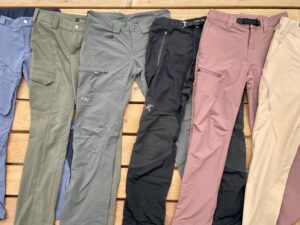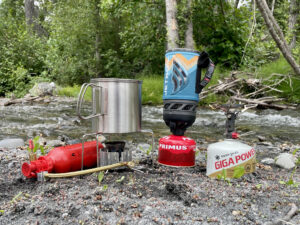One of the most critical pieces of fishing gear is a pair of fishing pliers. This simple but versatile tool is great for removing hooks from a fish’s mouth, cutting fishing lines, helping you build fishing lures, or manipulating treble hooks. Fishing pliers are a tool you can’t go fishing without and that you should always keep accessible in your tackle box or bag.
The best pliers for fishing will be crafted with either stainless steel or aluminum and will be versatile and durable. We’ve tested products, gone fishing with them, read fishing plier reviews, and compiled a guide to the best fishing pliers for your next fishing trip.
Best weight distribution: Booms Fishing X1 Aluminum Fishing Pliers
- Includes braided metal lanyard and hook attachment

- Durable aluminum construction
- Contoured handle for maximum dexterity
Booms Fishing X1 Aluminum Fishing Pliers come with a braided metal coiled lanyard, that you’ll want to attach to the sheath once the box arrives. The star of the show here is the perfect weight distribution between the 7.8” plier end, and the ergonomic handle; these two combined make this set of aluminum pliers all that more comfortable to use, especially when handling large fish! We were lucky enough to catch a large red drum while out fishing with this tool. The handles are designed with contoured finger inlays which helped me retain full control of the pliers during use.
The line cutters on this set can cut braided line, monofilament line, and fluorocarbon line. They feature line cutters, crimp sleeves, a crimp split lead, and a split ring in the nose. Aluminum is rust-resistant and this tool can be used for both fresh and saltwater fishing. Given their size, these are best for small to medium fish. Read the in-depth review here.
See Booms Fishing X1 Aluminum Fishing Pliers on Amazon
See Booms Fishing X1 Aluminum Fishing Pliers on Walmart
Best choice: Piscifun Aluminum Fishing Pliers
- Super-fine four-use plier end

- Sharp line-cutters are fully replaceable
- Primary tungsten carbide construction
Crafted out of highly durable tungsten carbide, the Piscifun pliers promise years of use with a high level of rust resistance. The business end of this device has a four-in-one use, including fine grooves to tackle different hook sizes, crimp sleeves, and crimp leads. Last but not least, the line-cutters are durable and replaceable. Instead of purchasing a whole new set of pliers or line cutters, I can swap out the line cutters as they dull.
This tool was usable straight out of the box, and easy to use when removing hooks from a large tilapia a friend caught. On cold days, a rubber grip on the handle would be nice so that your hands aren’t on cold metal.
See Piscifun Aluminum Fishing Pliers on Amazon
Most lightweight: Wolfyok Aluminum Fishing Pliers
- Includes braided lanyard and latch hook

- Ergonomic handle design helps you retain control
- Aluminum construction, stainless steel jaws
A combination of lightweight aluminum body and stainless steel jaws with Teflon coating makes this reliable pair of pliers fairly rust-resistant and unlikely to bend under pressure. If you’re looking for a fast, light, and affordable set of fresh or saltwater fishing pliers then the Wolfyok Aluminum Fishing Pliers might be a great choice. These split ring fishing pliers feature a finger inlay for all four fingers, as well as a raised curve at the end, which helps with a bit of extra pushing power when a hook gets awkwardly stuck.
As many pliers do, Wolfyok includes a metal braided lanyard and hook. They also did something unconventional here and put the line-cutters on the right-hand side of the pliers. This is an innovative placement that appears to work fine once you get used to it. Given the weight and 6.7in length, it’s best for small to medium fish.
See Wolfyok Aluminum Fishing Pliers on Amazon
Best medium-duty: Sanlike Aluminum Fishing Pliers
- Includes a braided metal lanyard and sheath

- Bulky handle helps with maximum grip
- Wide grooves help with multiple hook types and cutting the line
Many fishing pliers are made out of similar materials and similar designs because the brands know what works. The Sanlike Aluminum Fishing Pliers took this tried and tested design, then beefed up the handles, and added tungsten carbide line cutters and a camo pattern. The bulked-up handle allows larger hands more space and additional control when removing stubborn hooks.
The plier end is fairly small but includes a line-cutter at the base, as well as wide grooves and crimp sleeves along the plier body.
See Sanlike Aluminum Fishing Pliers on Amazon
Best design: Gerber Magniplier Locking Fishing Pliers
- Off-axis nose and spaced handles improve performance

- Includes braided metal lanyard and sheath with velcro closure
- Carbide cutters take ages to dull, can be sharpened
Gerber is one of our favorite brands, as they have excellent hunting gear and the Gerber Magniplier Locking Fishing Pliers are no exception. The usual fishing plier design was thrown out the window for this sleek, innovative, mostly black tool to be born. These fishing pliers are high-end and equipped with a carbide line-cutter that you’ll have to work hard to dull. Even at that point, it can be sharpened to avoid paying for replacements.
The entire design is ergonomic, from the handles to the finger inlay. Your nose end is off-axis to provide better grip on hook curves, while the handles are spaced enough to give you better dexterity and withstand added tension. Lastly, you’ll find a coiled lanyard and nylon sheath to protect the needle-nose tips and spring-loaded handles.
See Gerber Magniplier Locking Fishing Pliers on Amazon
See Gerber Magniplier Locking Fishing Pliers on Gerber
Best for saltwater fishing: BITE Fishing Pliers
- Full aluminum construction

- Off-center line-cutters with a wide range of use
- Ergonomic soft grip on both handles
BITE Footwear did something out of the box and made a remarkable pair of fishing pliers. The BITE Fishing Pliers are all corrosion-resistant aluminum and offer a large center hinge with a short handle gap. What that means is you have to apply very little pressure to put them into action, allowing for fast and easy hook removal, even on big fish.
The tungsten carbide cutters are off-center, sticking out from the side of the pliers, and boast a wide end on either side. That allows you to sharpen them in the future without turning them into nubs. Lastly, the ergonomic grip and soft-touch handles make this easy to use and keep your hands from touching chilly metal on cold days.
See BITE Fishing Pliers on Amazon
Best heavy-duty: Lews Aluminum Fishing Pliers
- Aircraft quality aluminum handles

- 303-grade stainless steel spring bearing
- Includes sheath and a wire braided metal lanyard
Not into flashy fishing pliers? We don’t blame you, and neither do Lews: they put together a rugged, no-fuss pair of pliers, and included a braided metal lanyard and sheath to go along with it. The real show-stoppers are the aircraft-grade aluminum handles and primary construction, stainless steel-lined plier nose with serrated jaws, and 303-grade steel spring bearings. In short, these pliers are built to outlast just about every other pair you can find.
While they may not feature some of the bells and whistles, sometimes basic pliers are a win and this option is excellent for heavy-duty use.
See Lews Aluminum Fishing Pliers on Amazon
Best titanium: Van Staal Titanium Fishing Pliers
- Full titanium construction

- Includes a leather sheath (open top)
- Steel side line-cutters
Are you ready to treat yourself? Van Staal offer a high-end line of fantastic tools and home products, and their fishing pliers are no exception. Crafted out of nothing but titanium, these pliers withstand rust, the test of time, and every drop and bump along the way.
These needle nose pliers are fantastic fishing pliers that truly shine because of their durability. Their hefty 15.2 ounces aid in durability and allow them to be used for difficult-to-remove hooks and big fish. The handles have inlays for your fingers to help with control and prevent slippage, while the steel wire cutters sit on the side. They can be replaced or sharpened. Lastly, Van Staal also include an open-top leather sheather.
See Van Staal Titanium Fishing Pliers on Amazon
See Van Staal Titanium Fishing Pliers on Walmart
Best light duty: ZACX Fishing Pliers
- Made from anodized aluminum

- Improved spring-loaded handle
- Sheath and lanyard included
- Upgraded fish gripper included
The ZACX Fishing Pliers are one of the most popular fishing pliers. Made from anodized aluminum, they’re designed to be used in both saltwater and freshwater without rusting. The ergonomic and lightweight design makes them perfect for those situations when your hands are already tired. Plus, they have an improved spring-loaded handle that makes them easy to operate with one hand.
In addition to the pliers, you get a polyester sheath and lanyard to keep them attached to your pants, tackle box, or bag. You also get an upgraded fish gripper, which makes it easier to remove hooks from the fish’s mouth. When you examine the nose you’ll find a split ring tip, sharp teeth, and crimp and press leads.
See ZACX Fishing Pliers on Amazon
See ZACX Fishing Pliers on Walmart
Most ergonomic: KastKing Cutthroat 7” Fishing Pliers
- Made from corrosion-resistant stainless steel

- Comfortable rubber handle
- Tungsten carbide cutters
- Polyester holster included
- Extendable lanyard
KastKing is one of our favorite fishing brands. Run by a bunch of fishing experts, their products are designed to make fishing easier and more enjoyable. The KastKing Cutthroat 7in Fishing Pliers are made from corrosion-resistant stainless steel and come with a comfortable rubber handle. They’ve also got a pair of carbide cutters that will make quick work of fishing lines.
In addition to the pliers, you get a polyester holster and an extendable lanyard to stop you from losing them. Our favorite features are the versatile nose and rubber grip on the handle. The rubber grip is welcome in the cold hours of the morning when you don’t want your fingers to get any colder touching metal.
See KastKing Cutthroat 7” Fishing Pliers on Amazon
Why trust us
For this guide, I turned to the best angler I know, my father. To test products, we went fishing together and combined my knowledge of the outdoors and gear testing with his understanding of fishing. Together we made a great team and made friends at the lake who also used our gear and gave feedback for a more well-rounded fishing experience.
Who this is for
This guide is for the novice to the intermediate angler. More advanced fisherman and women will have their preferences but that doesn’t mean they can’t use this guide as a jumping-off point. We offer salt and freshwater options, needle-nose style pliers, and the best split ring pliers. We also offer a variety of materials to consider when buying. In this guide, you’ll find titanium, aluminum, and stainless steel fishing pliers.
How we picked
To curate a selection of the best fishing pliers, I first looked for the top sellers and most well-reviewed options. From there, I consulted anglers I knew and asked their opinions. When adding products, I wanted to ensure we had some options in a variety of materials, weights, and heavy/medium and light duty. I believe in well-rounded guides that serve as many people as possible.
How we tested
Well, the best way to test fishing pliers is to go fishing! I opted to go to Braunig Lake with my father. We used live bait and hoped to catch carp, bass, or red drum. While fishing, we met several other folks and allowed them to use the gear we were testing as well to collect their feedback. The more input, the better.

Features to look for in fishing pliers
Material
We like to see high-grade aluminum and stainless steel, or titanium. However, titanium is less common and typically more expensive. Brands that use shoddy materials for the main body of their fishing pliers aren’t the types of companies that put great detail and care into the supporting components, like springs and spring bearings. Furthermore, aluminum and steel can handle the tension of your hands without warping over time. The only caveat is that you need to ensure the aluminum is aircraft grade or it runs the risk of bending and warping.
Durability
This is where material heavily indicates how long you’ll have these pliers. If your spring or spring bearings aren’t good quality, but the primary material is stainless steel, then you’ll be on the fast track to having a useless set of stainless steel pliers. Durability comes from brand dependability and quality materials from tip to grip. Titanium and stainless steel offer the most durability but aircraft-grade aluminum is close behind.
Weight
Weight can be both a benefit and a hindrance. For small hands or a fast and light fly fishing trip, you may want to opt for a lightweight set of pliers. When it comes to torque, durability, and working with larger fish, you’ll want a little extra heft to your aluminum pliers or stainless steel fishing pliers.
Grip
The grip does more than just make contact with your skin more pleasant, it helps with proper tension application and prevents your hand from slipping. Depending on how much pressure you use to keep the hook in place during extraction, you’ll be relying on your grip to pick up the slack. A good grip will have individual finger inlays and either a rugged end (found on full-bodied aluminum fishing pliers) or a soft touch rubber coating. I’m personally a fan of rubber coatings to reduce fatigue and limit how cold your hands get.
Additional tools
Most notably, you’ll want to look for a line-cutter included in your fishing pliers. Not all of them feature this, but it cuts down on extra weight, bringing along an extra tool, and can save you time. You’ll be able to cut your line without finagling with your fishing vest, and for catch and release fishers, this is critical time to get the fish back in the water.
Lanyard
Where else are you going to put these? Your lanyard isn’t essential, but it is useful. You’re going to see just about every brand include a metal braided lanyard, standard hooks, and in some cases, they’ll also toss in a sheath to keep your pliers protected when not in use. When you’re handling aluminum or steel, you’ll want to ensure that the locking mechanism works well before you simply hang this off a lanyard on your fishing vest.
Side and line cutters
A line or side cutter can be made with a variety of materials but our preference is tungsten carbide. Tungsten cutters will be more durable and last longer. We also recommend finding a model that you can either sharpen the blades when they dull or replace them.
Rustproofing/corrosion protection
Given that your fishing pliers will undoubtedly come into contact with water, corrosion resistance is a must. Quality fishing pliers must not rust. Stainless steel, titanium, and aluminum pliers will all offer some corrosion resistance with titanium and stainless steel offering more.
Length
The most common length we see in the best fishing pliers is six inches to eight inches. When choosing your length, you’ll want to think about the size of your hand and what feels comfortable, as well as the type and size of fish you’ll be catching. You may need some extra length to grab a stubborn fish hook.
Split ring tool
Split rings are often used to assemble fishing lures, replace treble hooks, and assemble tackle. Small split rings are difficult to open by hand and many fresh and saltwater fishing pliers now have split ring tips (or you can also find split ring pliers). A split ring tool on the nose allows you to open these rings easily, without fuss. If you are using pre-assembled lures and tackle, you may not need this, but in general, a split ring tip is a handy fishing tool.
Crimper
When assembling a rig or lure, crimping jaws can be handy. While it is possible to crimp with your regular needle-nose pliers for fishing, many of the best fishing pliers also feature specific crimping tools in the nose which are helpful if you regularly build your own rigs or lures.

Fishing pliers FAQ
Q: How do you remove a hook using pliers?
A: You might not be able to catch and release the fish if the hook is too deep. If it isn’t, then you’re going to want to act quickly, but calmly. Using the needle-nosed end of the pliers, grasp the hook at the point where it curves. Gently twist it in the direction of your line (away from the point of contact with the fish to avoid digging the hook in further). You might have to wiggle your hands slightly if you’re getting increased resistance from the hook.
Using fishing pliers allows you to have a hands-off approach, for the most part. Fish have a slimy mucus exterior that protects them, so for catch and release fishers, it means you only have to put one hand on them while the other maneuvers the pliers and removes the hook. It’s better for the fish, and quicker to get them back in the water.
Q: Do you need spring-loaded pliers?
A: If your spring-loaded pliers encounter an issue with the bearing, or just start to wear down after all that use, then they’re still going to be viable to use. You can still manually open them, close them on the hook and apply tension, they’ll still work just fine.
However, if you buy spring-loaded pliers, you’re expecting an easier time. The spring keeps them open, so you simply retrieve them from their sheath or your fishing vest, they pop open, and you have fast access to get rid of the hook.
Whether or not to go with spring-loaded handles or spring-loaded jaws is truly a matter of preference. There’s debate on the pros and cons, but this tool is extremely simple, and going with a manual pair over spring-loaded isn’t going to prohibit their viability, or decrease your skill with them.
Q: How to care for your pliers?
A: Most fishing pliers are made out of steel or aluminum but you will also run into titanium pliers. You aren’t going to see a lot of ABS plastic or engineered hard nylon here. You’re obviously aware of metal’s number one enemy, the water. More importantly, saltwater. Even with the highest grade stainless steel available for purchase, you can still damage your fishing pliers if you leave them out in improper conditions.
Assuming that you’ve found yourself an excellent pair of steel or high-grade aluminum fishing pliers, these are all the steps you can take to ensure they stay up to par. These tips go in no particular order.
- Everything in its place: Don’t make the mistake of leaving your pair of fishing pliers hanging in your fishing vest. Not only does it leave them susceptible to falling (if you hang your vest on a rack), but they’re also more likely to get knocked around. Get a designated space, and don’t leave them in your vest.
- Grease regularly: If you’ve snagged some fishing pliers that seem more like a Swiss Army Knife, then you’ll need to spend extra time greasing each moving part appropriately. Rust doesn’t just form on its own, it can creep into your pliers when you aren’t greasing them in the first place. Oil and water don’t mix, so not only are you keeping your fishing pliers operational, but you’re protecting them from unknown splashes and contact with the water.
- Understand what you’re cutting through: It’s very easy to make the mistake of overestimating your pliers. If you opted for a lower-grade aluminum pair and you’re trying to cut through steel wire, you’re only going to damage your pliers and end up frustrated. Keep a mental inventory of the metal grades of wire and fishing line that you’re using, so you don’t make a simple mistake and ruin your pliers forever.
- Sharpen quarterly: If you’re getting these because you’re a hardcore angler, you’re not going to let three months go by without using them. If you fish as often as we do, you’ll notice that even from proper use, the edges of the pliers are going to get dull with time and application. Sharpen them regularly and pay attention to any additional aspects (fold-out knives, for example). Keep in mind that some cutters (even on expensive fishing pliers) are supposed to be replaced, not sharpened. Consult the manufacturer before sharpening.
- Don’t use them for other tasks: These aren’t all-purpose pliers, and they shouldn’t be treated as such. Fishing pliers are made for a very specific purpose.
Sources:
- Split Rings – Takemefishing.org
- A Guide To Fishing For The First Time – U.S. Fish and Wildlife Service






